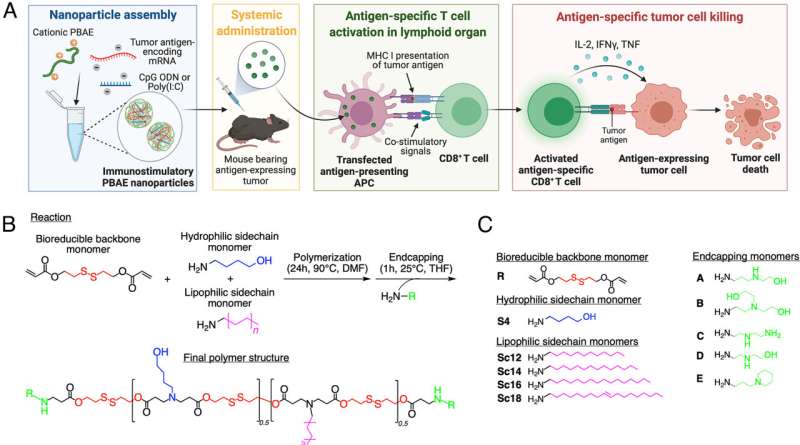This article has been reviewed according to Science X's editorial process and policies. Editors have highlighted the following attributes while ensuring the content's credibility:
fact-checked
peer-reviewed publication
trusted source
proofread
Scientists design a nanoparticle that may improve mRNA cancer vaccines

Johns Hopkins Medicine scientists say they have developed a nanoparticle—an extremely tiny biodegradable container—that has the potential to improve the delivery of messenger ribonucleic acid (mRNA)-based vaccines for infectious diseases such as COVID-19, and vaccines for treating non-infectious diseases including cancer.
Results of tests in mice, reported June 20 in the Proceedings of the National Academy of Sciences, show that the degradable, polymer-based nanoparticle carrying an mRNA-based vaccine, when injected into the bloodstream of mice, was able to travel to the spleen and activate certain cancer-fighting immune cells in a targeted way.
The researchers also found that mice with melanoma survived twice as long, and twice the number of mice with colorectal cancer survived long-term, following an injection of the Johns Hopkins-made nanoparticles compared with mice that received control treatments.
In addition, the scientists found that throughout the mice, about half of the specialized immune cells responsible for recognizing and destroying unhealthy cells such as those infected with viruses or cancer, had been activated and primed to recognize the specific invading cancer cells.
Nanoparticles made from lipids (a type of fatty acid) are the basis for mRNA COVID-19 vaccines. Such lipid-based, preventive vaccines are typically injected into muscle.
However, while muscle contains many cells capable of expressing mRNA that can lead to an antibody response, there are relatively few dendritic cells—immune cells that teach the rest of the immune system, in particular T-cells, to seek and destroy cancer cells. Scientists may be able to improve cancer treatment-focused vaccines by enhancing their ability to reach dendritic cells with their mRNA instructions.
Injecting lipid-based vaccines into the bloodstream has proved difficult because the vaccines tend to travel directly to the liver, where they are degraded.
"Our goal was to develop a nanoparticle that wouldn't be sent directly to the liver and could effectively teach immune system cells to seek and destroy the appropriate target," says Jordan Green, Ph.D., professor of biomedical engineering at the Johns Hopkins University School of Medicine.
Green explains that to make stronger vaccines for infectious disease and for noninfectious disease, such as cancer, the nanoparticle's mRNA contents are needed to reach, enter and be expressed in dendritic cells. After the mRNA is expressed in dendritic cells, it is quickly degraded, and the resulting immune cell response can last much longer after the mRNA and nanoparticles are long gone, say the researchers.
Customarily, scientists have accomplished this cell targeting by attaching proteins to a nanoparticle that bind specifically, like a lock and key, to a target cell's surface. However, in laboratory tests of this approach, only a small percentage of nanoparticles reach the target cell, and the scientists say there are manufacturing challenges with such approaches.
Green and his team tested various materials and ultimately decided to encase a desired mRNA in a polymer-based vessel. Polymers are repetitive groups of small molecules that form a tightly bonded chain to create a larger molecule, and they can be designed to biodegrade back to small molecules in the body. Green's team engineered the nanoparticle's ratio of water-loving to water-phobic molecules just right—a key to making the nanoparticle more apt to encapsulate mRNA, and making it easier to enter the target cell.
Then, Green's team used disulfide bonds to make the nanoparticles degrade quickly inside the target cell. The polymers used to construct the nanoparticles contained end-capping molecules that have an affinity for a specific tissue type.
Finally, Green and his team added a "helper," also known as an adjuvant, to the nanoparticle. The adjuvant helps activate the dendritic cell.
In experiments of cells grown in the laboratory, the researchers found that the nanoparticle configuration they developed was taken up by primary dendritic cells at levels about fifty-fold higher than mRNA by itself. In mice, nearly 80% of cells in the spleen that the nanoparticles reached were the target dendritic cells.
In one set of experiments, the researchers used mice with immune cells genetically engineered to glow red if the nanoparticle was opened to reveal its mRNA contents. They found that 5% to 6% of all dendritic cells in the spleen successfully took up, opened and processed the nanoparticle, and that this happened mostly in dendritic cells compared with other immune cells including macrophages, monocytes, neutrophils and T-cells.
"The immune system is designed to work through an amplified response, where dendritic cells teach other immune cells what to look for in the body," says Green.
Later experiments showed that half of mice with colorectal cancer survived long-term after receiving two injections of the new nanoparticle formulation plus an immunotherapy drug, compared with 10% to 30% that survived after treatment with other nanoparticle formulations and an immunotherapy drug or the immunotherapy drug alone.
Of the long-term surviving mice with colorectal cancer, all of them lived without additional treatment when the researchers gave them additional colorectal cancer cells, suggesting a long-term immunological response that prevented the cancer from returning.
The researchers also found that 21 days after treatment with the new nanoparticle, 60% of the cell-killing T-cells in the mice were armed to recognize and attack the colorectal cells. Similarly, in mice with melanoma, about half of the same type of T-cells were primed to attack melanoma.
"The nanoparticle delivery system was able to create an army of T-cells that can recognize cancer-linked antigen," says Green.
"This new nanoparticle delivery system may improve the way vaccines are given for infectious disease, and it may open a new avenue for treating cancer as well," Green says.
More information: Elana Ben-Akiva et al, Biodegradable lipophilic polymeric mRNA nanoparticles for ligand-free targeting of splenic dendritic cells for cancer vaccination, Proceedings of the National Academy of Sciences (2023). DOI: 10.1073/pnas.2301606120
Journal information: Proceedings of the National Academy of Sciences
Provided by Johns Hopkins University School of Medicine





















